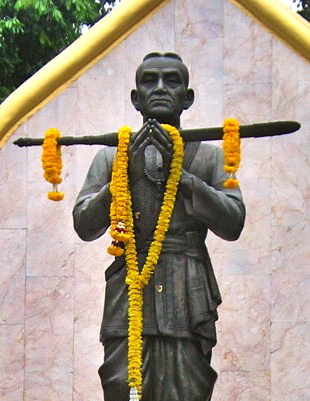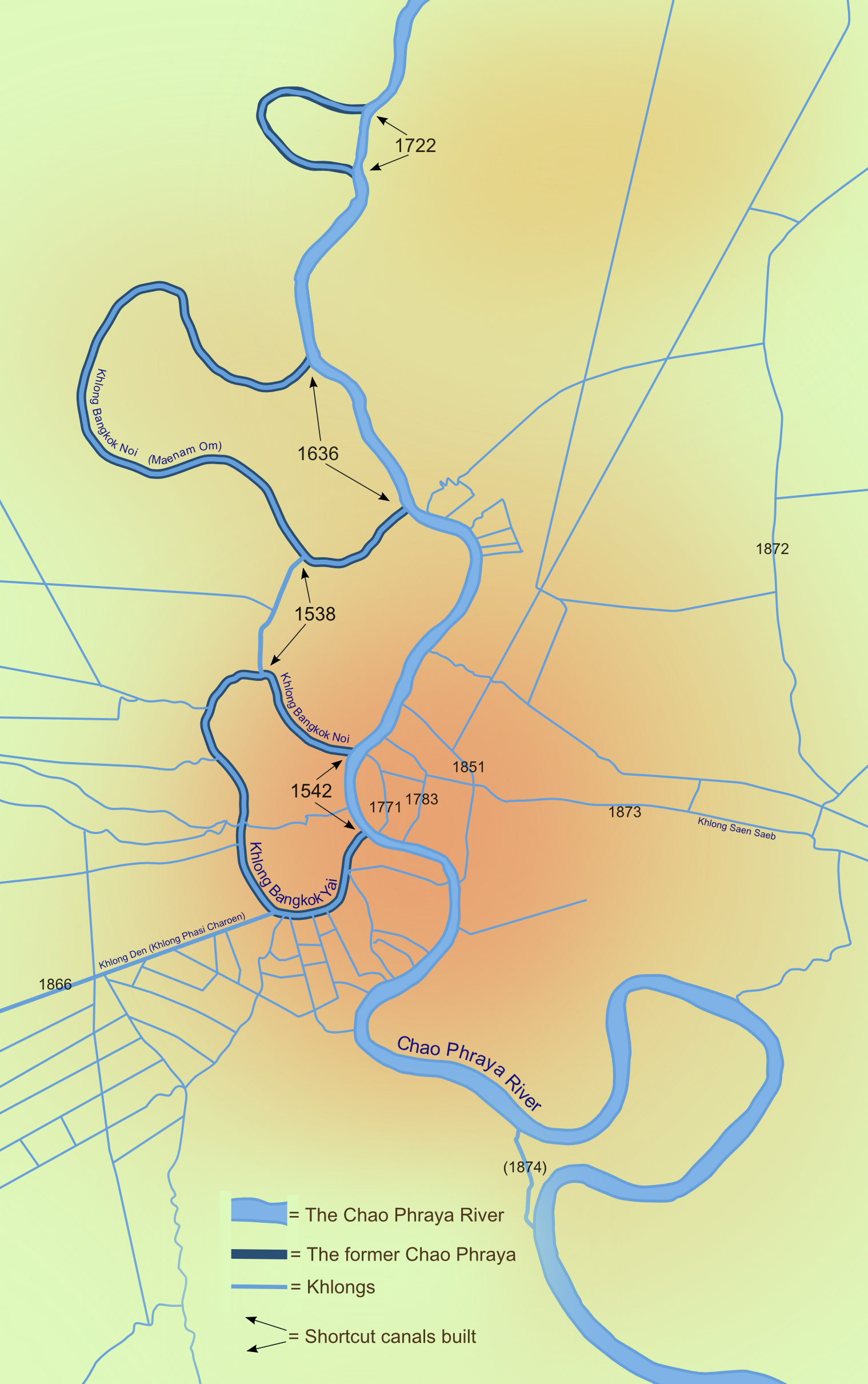|
Wat Suwan Keree
Wat Suwan Khiri, also spelled Wat Suwan Keree ( th, วัดสุวรรณคีรี) is an ancient Thai Buddhist temple in Thonburi side of Bangkok. The temple is formerly and still colloquially known as "Wat Khi Lek" (วัดขี้เหล็ก) owing to a lot of growth edible plants Siamese cassia (''Senna siamea'') or ''khi lek'' in Thai language. It was built in the end of King Narai's reign of Ayutthaya period around 1685. The interesting point of this temple is its location, it is located on the bank where two canals confluence were Khlong Bangkok Noi and Khlong Chak Phra, which is unsuitable position according to the beliefs of Thai people since ancient times. Hence, the temple therefore had to bring a standing Buddha image in attitude of pacifying the ocean enshrined in a pavilion at this area there to protect the temple from all evils. In the Rattanakosin period, Prince Maha Sura Singhanat (younger brother of King Rama I) renovated the whole temple ... [...More Info...] [...Related Items...] OR: [Wikipedia] [Google] [Baidu] |
Theravada
''Theravāda'' () ( si, ථේරවාදය, my, ထေရဝါဒ, th, เถรวาท, km, ថេរវាទ, lo, ເຖຣະວາດ, pi, , ) is the most commonly accepted name of Buddhism's oldest existing school. The school's adherents, termed Theravādins, have preserved their version of Gautama Buddha's teaching or ''Dharma (Buddhism), Buddha Dhamma'' in the Pāli Canon for over two millennia. The Pāli Canon is the most complete Buddhist canon surviving in a Indo-Aryan languages, classical Indian language, Pali, Pāli, which serves as the school's sacred language and ''lingua franca''.Crosby, Kate (2013), ''Theravada Buddhism: Continuity, Diversity, and Identity'', p. 2. In contrast to ''Mahāyāna'' and ''Vajrayāna'', Theravāda tends to be conservative in matters of doctrine (''pariyatti'') and monastic discipline (''vinaya''). One element of this conservatism is the fact that Theravāda rejects the authenticity of the Mahayana sutras (which appeared c. ... [...More Info...] [...Related Items...] OR: [Wikipedia] [Google] [Baidu] |
Khlong Chak Phra
Khlong Chak Phra ( th, คลองชักพระ, ) is a ''khlong'' (canal) in Bangkok's Thonburi area. It separates from Khlong Bangkok Noi at front of Wat Suwan Keree and terminates at the confluence of khlongs Mon and Bangkok Yai. It serves as a demarcation line between Bangkok Noi and Taling Chan Districts all the length. It is about 10-15 m (36-49 ft) wide and 5.45 km (about 3 mi) long. Khlong Chak Phra is a natural khlong, which was the result of dissection of the Chao Phraya River's original route through Bangkok during the medieval Ayutthaya like Khlong Bangkok Yai and Khlong Bangkok Noi. Its name means 'pulling the Buddha canal'. It is a venue that is used for the annual tradition called '' Chak Phra'', in which the Buddha's relics and Buddha statues are invited from Wat Nang Chi in Phasi Charoen District onto a flowered barge. The barge procession then sails from Khlong Dan, turning left into Khlong Bangkok Yai, entering Khlong Bangkok Noi, passing Wat Kai Tia a ... [...More Info...] [...Related Items...] OR: [Wikipedia] [Google] [Baidu] |
Buddhist Temples In Bangkok
Buddhism ( , ), also known as Buddha Dharma and Dharmavinaya (), is an Indian religion or philosophical tradition based on teachings attributed to the Buddha. It originated in northern India North India is a loosely defined region consisting of the northern part of India. The dominant geographical features of North India are the Indo-Gangetic Plain and the Himalayas, which demarcate the region from the Tibetan Plateau and Central ... as a -movement in the 5th century BCE, and Silk Road transmission of Buddhism, gradually spread throughout much of Asia via the Silk Road. It is the Major religious groups, world's fourth-largest religion, with over 520 million followers (Buddhists) who comprise seven percent of the global population. The Buddha taught the Middle Way, a path of spiritual development that avoids both extreme asceticism and hedonism. It aims at liberation from clinging and craving to things which are impermanent (), incapable of satisfying ('), and witho ... [...More Info...] [...Related Items...] OR: [Wikipedia] [Google] [Baidu] |
Bangkok Noi District
Bangkok Noi ( th, บางกอกน้อย, ) is one of the 50 districts (''khet'') of Bangkok, Thailand. Neighboring districts are (from north clockwise) Bang Phlat, Phra Nakhon (across Chao Phraya River), Bangkok Yai, Phasi Charoen, and Taling Chan. History Bangkok Noi was established as an amphoe on 15 October 1915. Originally named Amphoe Ammarin, it was renamed on 11 July 1916 to Amphoe Bangkok Noi to match with the historical name of the area. It became a khet in 1972 when Thon Buri and Bangkok were merged. Later on 9 November 1989 the Bang Phlat district was created from four of Bangkok Noi's sub-districts, leaving Bangkok Noi with four remaining sub-districts: Siri Rat, Ban Chang Lo, Bang Khun Non, and Bang Khun Si. On 12 December 1991 a small part of Bang Phlat district was moved back to Bangkok Noi, creating the new Arun Ammarin sub-district. Symbols The district seals shows the head of the royal barge Sri Suphunahongsa. The slogan of the district is ''Resonant ... [...More Info...] [...Related Items...] OR: [Wikipedia] [Google] [Baidu] |
Kathin
Kathina is a Buddhist festival which comes at the end of Vassa, the three-month rainy season retreat for Theravada Buddhists in Bangladesh (known as Kaṭhina Cībar Dān), Cambodia, Laos, Malaysia, Myanmar, Singapore, Sri Lanka, India, Thailand, and Vietnam.Kathina at The season during which a monastery may hold Kathina is one month long, beginning after the full moon of the eleventh month in the (usually October). It is a time of giving, for the laity to express gratitude to |
Prajadhipok
Prajadhipok ( th, ประชาธิปก, RTGS: ''Prachathipok'', 8 November 1893 – 30 May 1941), also Rama VII, was the seventh monarch of Siam of the Chakri dynasty. His reign was a turbulent time for Siam due to political and social changes during the Revolution of 1932. He is to date the only Siamese monarch of the Chakri Dynasty to abdicate. Early life Somdet Chaofa Prajadhipok Sakdidej ( th, สมเด็จเจ้าฟ้าประชาธิปกศักดิเดชน์) was born on 8 November 1893 in Bangkok, Siam (now Thailand) to King Chulalongkorn and Queen Saovabha Phongsri. Prince Prajadhipok was the youngest of nine children born to the couple. Overall he was the king's second-youngest child (of a total of 77), and the 33rd and youngest of Chulalongkorn's sons. Unlikely to succeed to the throne, Prince Prajadhipok chose to pursue a military career. Like many of the king's children, he was sent abroad to study, going to Eton Colle ... [...More Info...] [...Related Items...] OR: [Wikipedia] [Google] [Baidu] |
King Rama I
Phra Phutthayotfa Chulalok Maharaj (, 20 March 1737 – 7 September 1809), personal name Thongduang (), also known as Rama I, was the founder of the Rattanakosin Kingdom and the first monarch of the reigning Chakri dynasty of Siam (now Thailand). His full title in Thai is ''Phra Bat Somdet Phra Paramoruracha Mahachakkriborommanat Phra Phutthayotfa Chulalok'' (). He ascended the throne in 1782, following the deposition of King Taksin of Thonburi. He was also celebrated as the founder of Rattanakosin (now Bangkok) as the new capital of the reunited kingdom. Rama I was born from a Mon male line descent family, great-grandson of Kosa Pan. His father served in the royal court of the Ayutthaya Kingdom, and had served King Taksin in wars against the Burmese Konbaung dynasty and helped him in the reunification of Siam. During this time he emerged as Siam's most powerful military leader. Thongduang was the first '' Somdet Chao Phraya'', the highest rank the nobility could attain, ... [...More Info...] [...Related Items...] OR: [Wikipedia] [Google] [Baidu] |
Maha Sura Singhanat
Somdet Phra Bawornrajchao Maha Sura Singhanat ( th, สมเด็จพระบวรราชเจ้ามหาสุรสิงหนาท; , lit: ''His Royal Highness, Maharurasinghanat, Prince of Front Palace'') (1 November 1744 – 3 November 1803) was the younger brother of Rama I, the first monarch of the Chakri dynasty of Siam. As an Ayutthayan general, he fought alongside his brother in various campaigns against Burmese invaders and the local warlords. When his brother crowned himself as the king of Siam at Bangkok in 1781, he was appointed the Front Palace or Maha Uparaj, the title of the heir. During the reign of his brother, he was known for his important role in the campaigns against Bodawpaya of Burma. Early life Bunma was born in 1744 to Thongdee and Daoreung. His father Thongdee was the Royal Secretary of Northern Siam and Keeper of Royal Seal. As a son of aristocrat, he entered the palace and began his aristocratic life as a royal page. Thongdee was a de ... [...More Info...] [...Related Items...] OR: [Wikipedia] [Google] [Baidu] |
Thai People
Thai people ( th, ชาวไทย; ''endonym''), Central Thai people ( th, คนภาคกลาง, sou, คนใต้, ตามโพร; ''exonym and also domestically'') or Siamese ( th, ชาวสยาม; ''historical exonym and sometimes domestically''), T(h)ai Noi people ( th, ไทยน้อย; ''historical endonym and sometimes domestically''), in a narrow sense, are a Tai ethnic group dominant in Central and Southern Thailand (Siam proper). Part of the larger Tai ethno-linguistic group native to Southeast Asia as well as Southern China and Northeast India, Thais speak the Sukhothai languages ( Central Thai and Southern Thai language), which is classified as part of the Kra–Dai family of languages. The majority of Thais are followers of Theravada Buddhism. As a result of government policy during the 1930s and 1940s resulting in successful forced assimilation of many the various ethno-linguistic groups in the country into the dominant Thai language and ... [...More Info...] [...Related Items...] OR: [Wikipedia] [Google] [Baidu] |
Khlong Bangkok Noi
250px, Khlong Bangkok Noi near Wat Sri Sudaram Khlong Bangkok Noi ( th, คลองบางกอกน้อย, ; lit 'Small Bangkok Canal') is a '' khlong'' (คลอง; canal) in Bangkok; its name is the origin of the name Bangkok Noi District. The mouth of Khlong Bangkok Noi is located beside Siriraj Piyamaharajkarun Hospital (SiPH) and the former Bangkok Noi railway station (now the location of Thonburi Railway Station Pier). The current flows north through many historical and cultural landmarks, such as Ansorissunnah Royal Mosque, National Museum of Royal Barges, Wat Suwannaram, Thon Buri railway station, Wat Amarintharam, and Wat Si Sudaram, a Thai temple known as the place where the poet Sunthorn Phu studied in his childhood, as well as Wat Bang Oi Chang in Nonthaburi Province, etc. The canal terminates at the confluence with Khlong Om Non and Khlong Bang Yai at the Old Bang Yai Market in Bang Yai District, Nonthaburi Province, along the way, it is also connect ... [...More Info...] [...Related Items...] OR: [Wikipedia] [Google] [Baidu] |



.jpg)


